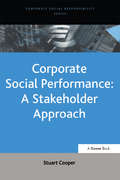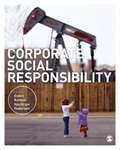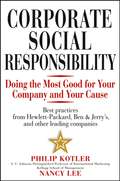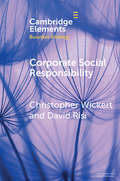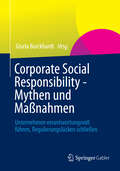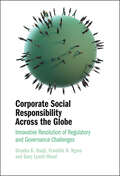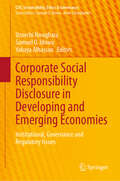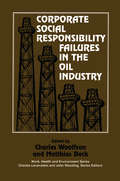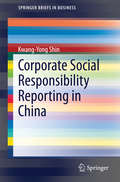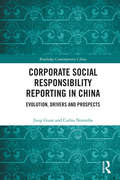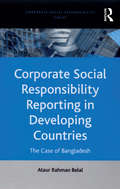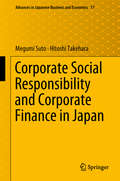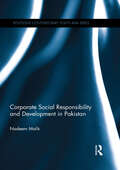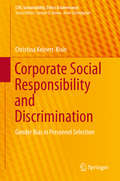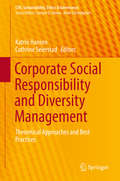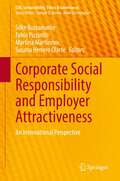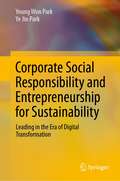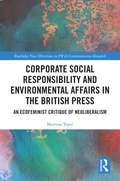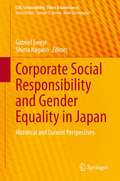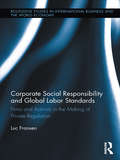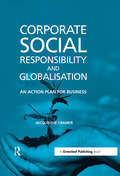- Table View
- List View
Corporate Social Performance: A Stakeholder Approach (Corporate Social Responsibility Series)
by Stuart CooperCorporate social performance has come of age. In a business environment characterized by its perpetual state of flux, the ability to recognize and react to global forces becomes paramount. The fallout of such rapid change - the fast-paced developments in communications and technology, the continual change to global markets, shifting demographics, the homogenization of personal values - have all contributed to the widespread new interest in issues such as ecology and environment, human rights and diversity, health and well-being, and communities. All of these issues are now potential liabilities for companies, and are very much back on the agenda for business. Once regarded as peripheral management concerns, they are now recognized as hard to predict and hard for business to deal with when they go wrong. This book offers an insight into how corporate social performance can be measured and why this is an important aspect of corporate social responsibility. Using detailed case studies, it provides readers with the foundations for understanding and applying corporate social performance, providing a stakeholder framework by which corporate social performance can be measured, alongside a detailed consideration of the value of different stakeholder measures. The book also applies this framework to new social accounting standards, enabling the reader to consider the validity and appropriateness of these standards. The increasingly important role of the internet for corporate social reporting is also considered.
Corporate Social Responsibility
by Mette Morsing Andreas Rasche Jeremy MoonAlthough the idea of social responsibility has a long and distinguished intellectual pedigree, Corporate Social Responsibility (or 'CSR') has re-emerged during the last fifteen years or so as a high-profile concept in both academia and business practice. This revitalized interest has come about largely because of the development of the 'markets for virtue' that have institutionalized CSR in business practices in an unprecedented manner. CSR has achieved organizational distinctiveness within companies (e. g. in managerial and board responsibilities); social and environmental reporting requirements have dramatically increased; socially responsible investment funds have not only established themselves in their own right, but have also informed more mainstream investment criteria, particularly regarding social and environmental risk; a CSR consultancy industry has emerged, along with various 'vanguard groups' and NGOs who seek not only to promote CSR, but also to bring critical perspectives to bear and to raise CSR standards; and governments around the globe have encouraged investment in CSR, better reporting of these activities, and the implementation of CSR initiatives that complement broader public policies. As research in and around CSR blossoms as never before, this new four-volume collection from Routledge's acclaimed Critical Perspectives on Business and Management series meets the need for an authoritative reference work to make sense of a rapidly growing and ever more complex corpus of literature. Edited by two scholars from Nottingham University's world-class International Centre for Corporate Social Responsibility, the collection gathers foundational and canonical work, together with innovative and cutting-edge applications and interventions. With a full index, together with a comprehensive introduction, newly written by the editors, which places the collected material in its historical and intellectual context, Corporate Social Responsibility is an essential work of reference. The collection will be particularly useful as an essential database allowing scattered and often fugitive material to be easily located. It will also be welcomed as a crucial tool permitting rapid access to less familiar--and sometimes overlooked--texts. For researchers, students, practitioners, and policy-makers, it is as a vital one-stop research and pedagogic resource.
Corporate Social Responsibility
by Esben Rahbek Pedersen*Shortlisted in the Management and Leadership Textbook Category at CMI Management Book of the Year Awards 2016* Instructors - Electronic inspection copies are available or contact your local sales representative for an inspection copy of the print version. Why has CSR become part of the mainstream business and academic agenda in the 21st century? How can CSR be fully integrated in business strategy and day-to-day operations? Do companies become more vulnerable to criticism from stakeholders if they make public their commitment to CSR? These are just some of the questions and challenges explored in this exciting new textbook. Readers will not only gain comprehensive knowledge and understanding of the history of CSR, the key CSR drivers, the main theoretical CSR perspectives and the dominant CSR practices found in the business community, they will also, more crucially, learn how to implement CSR in practice. Written and edited by leading academics in the field, Corporate Social Responsibility is an engaging and accessible text designed for any student seeking an introduction to this complex and ambiguous subject. Esben Pedersen is Professor at the CBS Center for Corporate Social Responsibility, Copenhagen Business School. Visit the Companion Website at (https://study.sagepub.com/pedersen) for annotated web links, free full-text journal articles and more.
Corporate Social Responsibility
by Esben Rahbek PedersenWhy has CSR become part of the mainstream business and academic agenda in the 21st century? How can CSR be fully integrated in business strategy and day-to-day operations? Do companies become more vulnerable to criticism from stakeholders if they make public their commitment to CSR? These are just some of the questions and challenges explored in this exciting new textbook. Readers will not only gain comprehensive knowledge and understanding of the history of CSR, the key CSR drivers, the main theoretical CSR perspectives and the dominant CSR practices found in the business community, they will also, more crucially, learn how to implement CSR in practice. Written and edited by leading academics in the field, Corporate Social Responsibility is an engaging and accessible text designed for any student seeking an introduction to this complex and ambiguous subject. Esben Pedersen is Professor at the CBS Center for Corporate Social Responsibility, Copenhagen Business School. Visit https://study.sagepub.com/pedersen for annotated web links, free full-text journal articles and more.
Corporate Social Responsibility
by Philip Kotler Nancy LeeToday, corporations are expected to give something back to their communities in the form of charitable projects. In Corporate Social Responsibility, Philip Kotler, one of the world's foremost voices on business and marketing, and coauthor Nancy Lee explain why charity is both good P. R. and good for business. They show business leaders how to choose social causes, design charity initiatives, gain employee support, and evaluate their efforts. They also provide all the best practices and cutting-edge ideas that leaders need to maximize their contributions to social causes and do the most good. With personal stories from twenty-five business leaders from socially responsible companies, this is the bible for today's good corporate citizen.
Corporate Social Responsibility (Elements in Business Strategy)
by Christopher Wickert David RisiThis Element offers a thought-provoking and critical examination of corporate social responsibility (CSR). CSR has entered the boardroom and become a mainstream management concept for businesses to address their ethical, social and environmental responsibilities towards society. CSR does not come without contestation, and firms engage in CSR for different reasons and exhibit different patterns of CSR activities. These activities range from sincere action with substantial social or environmental improvements to symbolic impression management and the creation of a CSR-façade that is little more than empty words. This Element illuminates and scrutinizes contemporary approaches to CSR and offers a fresh perspective for scholars, managers and decision-makers interested in the societal role of business firms beyond maximizing profitability. Christopher Wickert and David Risi take a step back from how CSR is currently understood and practiced, and stimulate readers to reflect on how to move CSR forward towards a more inclusive concept.
Corporate Social Responsibility - Mythen und Maßnahmen: Unternehmen verantwortungsvoll führen, Regulierungslücken schließen
by Gisela BurckhardtIn Zeiten der Globalisierung und Massenproduktion rückt verantwortungsvolle Unternehmensführung immer mehr in das Bewusstsein der Unternehmen. Damit Corporate Social Responsibility in Organisationen nicht als reine PR-Maßnahme angesehen wird, braucht es jedoch zunächst ein tiefes Verständnis, was sich hinter dem Begriff eigentlich verbirgt. Dieses Buch zeigt die Bandbreite von Unternehmensverantwortung zwischen Freiwilligkeit und Regulierung in globalen Lieferketten auf. Es stellt Maßnahmen und Initiativen von Unternehmen vor und gibt konkrete Empfehlungen, wie sinnvolle und nachhaltige CSR-Maßnahmen in Organisationen umgesetzt werden können.
Corporate Social Responsibility Across the Globe: Innovative Resolution of Regulatory and Governance Challenges
by Franklin N. Ngwu Onyeka K. Osuji Gary Lynch-WoodCorporate Social Responsibility Across the Globe demonstrates many ways that CSR can be applied by law to overcome regulation and governance challenges around the world. Using interdisciplinary and comparative models and perspectives, the book challenges dominant understandings of CSR, such as neoliberal voluntarism, and demonstrates the regulatory and governance implications of an interdependent relationship between CSR and the law. The book identifies substantive and procedural barriers for CSR in national, public, and private international law. By analyzing, deconstructing, and reframing CSR in these contexts, the book underlines opportunities for more effective application of CSR as a governance mechanism. Chapters investigate relevant regulation concepts, paradigms and approaches for CSR; methods for infusing CSR in corporate governance; and ways to facilitate private regulation of CSR in more developed, emerging, and developing jurisdictions.
Corporate Social Responsibility Disclosure in Developing and Emerging Economies: Institutional, Governance and Regulatory Issues (CSR, Sustainability, Ethics & Governance)
by Samuel O. Idowu Uzoechi Nwagbara Yahaya AlhassanThis book offers a new, nuanced, and comprehensive look at how CSR is practiced and disclosed in terms of corporate transparency, sustainability, and accountability, from the perspective of developing and emerging economies. Given the importance and power of emerging economies in shaping global gross domestic product (GDP), entrepreneurship, and corporate investment, it is crucial to examine this phenomenon in terms of corporate sustainability and achieving the ideals of the Sustainable Development Goals (SDGs) for a more sustainable future. The book therefore addresses contextual institutional, regulatory, and governance issues in these regions to contribute to the debate as well as a rethinking of the motivation for CSR practice and reporting. The book will be of interest to researchers, practitioners, and students.
Corporate Social Responsibility Failures in the Oil Industry
by Charles Woolfson and Matthias BeckCorporate Social Responsibility Failures in the Oil Industry directly challenges the oil industry's claims of corporate good citizenship, now widely advanced as part of a global public relations initiative. The volume spans the industry's reach, from the troubled waters of the UK offshore Continental Shelf, with its horrendous legacy of the Piper Alpha oil rig disaster, to the inhospitable shores of Newfoundland with its own tragic legacy of lost lives; to the new frontier of oil corporate colonialism in the former Soviet Union and the icy plains of Alaska. The central theme of violations of basic labour rights and of health and environmental protection standards will make uncomfortable reading in the boardroom. It is equally essential reading for those who seek to improve the position of workers and industries within the oil industry's global reach.
Corporate Social Responsibility Reporting in China (SpringerBriefs in Business)
by Kwang-Yong ShinThe CSR report has become a very important tool which can help corporations to set up strategies and build their core competencies. This book presents a range of cases from different industries. Based on the analysis of the enterprise survival environment, it points out the necessity and significance of CSR. The book analyzes the current situation and development trend of CSR in China, as well as its international developing trend. By analyzing the management framework and formulation process of the CSR report, this book provides businesses with guiding principles for preparing the CSR report.
Corporate Social Responsibility Reporting in China: Evolution, Drivers and Prospects (Routledge Contemporary China Series)
by Carlos Noronha Jieqi GuanIn recent years, Corporate Social Responsibility (CSR) reporting in China has been experiencing a rapid development and the number of social reports issued by Chinese enterprises shows a sharp increasing trend. This book investigates the evolution of such reporting practice in the country and the reasons behind it. In addition, it also examines the reporting quantity and quality of Chinese enterprises by applying the GRI (Global Reporting Initiative) as an evaluation tool. In response to policy documents so as to obtain the government’s recognition and to strive for more resources, state-owned enterprises, private enterprises and foreign-invested companies have made substantial efforts in social reporting in terms of quantity and coverage. However, it appears that there is still room for enhancing the quality of disclosure. The book also highlights the central government’s economic, political and social roles in promoting, encouraging and controlling the development of CSR reporting.
Corporate Social Responsibility Reporting in Developing Countries: The Case of Bangladesh (Corporate Social Responsibility Series)
by Ataur Rahman BelalHistorically, the study of corporate social responsibility (CSR) reporting has largely been within the context of Western economies. However, in the wake of highly publicized incidents such as Bhopal and the struggle of the Ogoni people in Nigeria, many large corporations now claim to be taking steps to improve their environmental and social performance within developing countries. Using the lens of stakeholder theory, this book examines whether the current practice of CSR reporting in developing countries is motivated by a desire to discharge accountability to all relevant stakeholders or whether it is being driven by the imperative of advancing corporate economic interests. While concepts like CSR reporting have become more fashionable, they vary widely in different national contexts; this book therefore clarifies the types and roles of CSR reporting and the underlying corporate motivations. The author considers the current CSR reporting practices in a number of developing countries, with particular attention given to illuminating a case study of Bangladesh.
Corporate Social Responsibility and Corporate Change: Institutional and Organizational Perspectives (Ethical Economy #57)
by Arnaud SalesThis wide-ranging book examines the new dynamics of corporate social responsibility (CSR) and the impact they have had on the transformation of business corporations. Written by an international group of distinguished experts in management and organization studies, economics and sociology, the book leads one to theoretically and practically rethink CSR, a movement that has developed into a strong and rich institutional domain since the mid 1990s. Through 14 chapters, the book shows the complexity, diversity and progression of the institutional work performed by a large number of individual and organizational actors in specialized networks to develop this strategic field. Central to this book are: the core issues associated with the field of CSR; recent advances in the development, dissemination and implementation of public and private standards of social responsibility; the pressing challenges of developing sustainable strategies of value creation in the face of global warming and underdevelopment; and finally, examples of how CSR has been implemented and institutionalized within business organizations with special attention to the role played by a variety of social actors in organizational change. Conceived as a movement, corporate social responsibility spearheads a transformation project challenging traditional and outmoded forms of corporate governance that frequently pose troublesome ethical issues. From this standpoint, Corporate Social Responsibility and Corporate Change will serve as a reference point for academics, researchers, managers and practitioners.
Corporate Social Responsibility and Corporate Finance in Japan (Advances in Japanese Business and Economics #17)
by Hitoshi Takehara Megumi SutoThis book explores the linkages between the evolution of corporate social responsibility (CSR) and corporate financing and governance in Japan since the late 2000s. Since the 1990s, increasing economic and financial globalization has steadily eroded the Japanese style of business based on relationships and influenced the awareness and practices of CSR that are unique to Japanese companies. In Japan’s two “lost decades” after the bubble economy, the business model and corporate financing seem to have continued a gradual financial reform toward a more market-oriented system. CSR awareness and practices of Japanese companies have been influenced by social and environmental issues that global society and communities face. Furthermore, the Fukushima nuclear accident in 2011 triggered increasing attention paid to the responsibility of business toward society. In this process, major players in corporate governance and components of governance structure have continued to change. The conventional view of Japanese corporate governance and corporate finance is too narrow to understand this field in Japan. This book is based on empirical research to investigate how multifaceted CSR has aligned with business and finance and has influenced the corporate governance structure of Japanese companies. The findings and discussions in this book act are stepping stones in further research on the linkages between business and society, and provide empirical evidence on changes in Japanese corporate finance and governance.
Corporate Social Responsibility and Corporate Governance
by Lorenzo SacconiCorporate social responsibility (CSR) is fast becoming a social demand and standard of behaviour in terms of the equitable treatment of corporate stakeholders to which all businesses feel they are expected to conform. Increasingly governance of corporations is viewed as accountable not just to shareholders but to multiple stakeholders, requiring an extension of the firm's fiduciary duties. Such ideas are even more topical after the last global financial crisis. This volume addresses the question: what does the rise of corporate social responsibility mean for economic theory? It considers, in particular, microeconomic theory and the theory of the firm alongside new-institutional and behavioural theories, game theory, stakeholder theory, incomplete contracts and law and economics. Drawing on the contributions of outstanding scholars like the Nobel laureate Oliver Williamson among others, it is shown that corporate social responsibility forces the economic theorist to engage with ideas emanating from other disciplines, including ethics, political philosophy and the law. The result is a set of essays that is perhaps more interdisciplinary than is usual for books on economic theory. This volume looks certain to establish itself as an invaluable text for scholars of economic theory, as well as their students in both advanced undergraduate and postgraduate courses. Part I explores the relation of CSR, offering different perspectives on the nature of the business firm and its governance structure based on human asset specificity, team production and the stakeholder approach (O. Williamson; M. Aoki;R. E. Freeman; A. Wicks and B. Parmar; A. Kaufman and E. Englander; and L. Stout and M. Blair). Part II considers alternative normative foundations of CSR and corporate governance based on models of the social contract, reputation effects, and collective rational agency (V. Vamberg; L. Sacconi; L. Andreozzi; and B. Chapman). Part III illustrates various approaches to the regulation and self-regulations of CSR, with special emphasis on social standards and multi-stakeholder organisations analysed alongside the more recent acquisition in behavioural economics (M. Blair, C. Williams and L. Lin; L. Becchetti and N. Pace; M. Osterloh, B. Frey and H. Zeitoun; A. Ben Ner, T. Ren and L. Putterman). "
Corporate Social Responsibility and Development in Pakistan (Routledge Contemporary South Asia Series)
by Nadeem MalikCorporate Social Responsibility (CSR) has not only become an important concept for corporate organizations but also civil society, community, state and the multilateral and bilateral development agencies. It has acquired great significance in the aftermath of the global financial crisis of 2008, not only in the advanced economies, but also in emerging and developing countries. In contemporary Pakistan problems of poverty, unemployment, illiteracy, and human rights violations are frequent. These problems cannot be dealt with by the state and civil society alone and call for corporate involvement. Backed by rich empirical data, based on extensive fieldwork and complemented with the official data sources, this book offers a detailed analysis of the socially responsible corporate policies and practices of companies operating in the emerging economy of Pakistan. Employing qualitative and quantitative research methods, it examines the sensitivity of companies in Pakistan to CSR measured in terms of their policies and perceptions about CRS, their CSR development activities, perceptions about development Non-Governmental Organisations, and channels and forms of support for development projects(both monetary and non-monetary). Filling a significant gap in our understanding of an important part of contemporary Pakistan’s development and the outlook of companies towards CSR, the book will be of interest to policymakers and scholars working in the fields of Development Studies, Business Studies and Asian Studies.
Corporate Social Responsibility and Discrimination: Gender Bias in Personnel Selection (CSR, Sustainability, Ethics & Governance #0)
by Christina Keinert-KisinThisbook presents and deconstructs the existing explanations for the differentialcareer development of qualified men and women. It reframes the problem ofdiscrimination in the workplace as a matter of organizational ethics, socialresponsibility and compliance with existing equal opportunity laws. Sensitivepoints are identified where social biases, decision-makers' individual economicinterests and shortcomings of organizational incentive policies may lead todiscrimination against qualified women. The ideas put forward are empiricallytested in an original laboratory experiment that examines personnel selectionin the male-dominated field of science and technology. It contrasts theselection of applicants with gendered and gender-blind applications availableto subjects under controlled conditions. 30% of participants were high-leveldecision-makers, which is unprecedented in this field of research. The results,highly relevant for organizational practice, are explained and discussed indetail.
Corporate Social Responsibility and Diversity Management: Theoretical Approaches and Best Practices (CSR, Sustainability, Ethics & Governance)
by Katrin Hansen Cathrine SeierstadThis book highlights the most critical aspects of diversity and their implications for Corporate Social Responsibility (CSR), examining them in a collection of conceptual and practical contributions from researchers and practitioners alike. In particular the book discusses good and best practices for diversity management and analyzes possible links between CSR and diversity within organizations. Examples are drawn from a diverse range of organizational settings including corporations, educational institutions and other (non-profit) organizations and in various countries, including Germany, the UK, the USA and India.
Corporate Social Responsibility and Employer Attractiveness: An International Perspective (CSR, Sustainability, Ethics & Governance)
by Silke Bustamante Fabio Pizzutilo Martina Martinovic Susana Herrero OlarteThis book investigates the preferences of young job seekers for different aspects of corporate social responsibility (CSR) in comparison to other non-CSR related employer attributes. It takes into account the potential influence of cultural and socio-economic variables and provides a differentiated global perspective. In its first part the book gives an overview about the impact of CSR on employer attractiveness and explains the factors that potentially influence CSR preferences of young job seekers all over the world. In a second part the research design is outlined and employer related preferences of 4783 graduates and students coming from 22 countries across the globe are discussed. In the third part, research results are presented for different cultural clusters. The most important criteria for employer choice of respondents are reflected against the socio-economic background and against the characteristics of CSR of the countries in question. Finally, the results are summarized and implications for global employer branding are derived.
Corporate Social Responsibility and Entrepreneurship for Sustainability: Leading in the Era of Digital Transformation
by Young Won Park Ye Jin ParkThis book addresses the dilemma that firms face in engaging in corporate social responsibility (CSR) while maintaining a financially sustainable business model in the era of digital transformation. Several strategies that firms have taken to integrate CSR within the business model are also highlighted. To explicate the problems involved, the book primarily focuses on entrepreneurial ventures, given their nascent business model that best illustrates how business leaders can embed the social mission in the firm at the beginning of organizational founding. In this age, sustainability is an innovation’s new frontier. For sustainable competitive advantage, the book argues for how companies can build more sustainable products, processes, and practices that benefit the firm and society through maintaining an entrepreneurial philosophy. The target readership consists of academics, students, and practitioners in the areas of entrepreneurship, organizational behavior, organizational theory, and strategic management. This book clarifies the critical practices of sustainability-oriented innovative firms and creative small and medium-sized enterprises (SMEs). Through a review of recent trends in CSR, the authors emphasize that CSR is no longer a “bolt-on” or some kind of window-dressing to satisfy public relations (PR) needs. Credible CSR is critical to business legitimacy and sustainability. Aware of the public’s increasing scrutiny, companies are increasingly ramping up their focus on social responsibility, whether by championing women's rights, protecting the environment, or attempting to obliterate poverty, on local, national, or global levels. Simultaneously, more firms face accusations of “greenwashing” – backlash due to consumer mistrust in the intentions behind their CSR practices. While numerous works have highlighted this dilemma and how companies fall short in their prosocial goals or financial objectives (or both), there is a lack of understanding of the ingredients and crucial processes required for the successful implementation of CSR in entrepreneurial enterprises. This book serves to fill that gap.
Corporate Social Responsibility and Environmental Affairs in the British Press: An Ecofeminist Critique of Neoliberalism (Routledge New Directions in PR & Communication Research)
by Martina TopićAn ecofeminist criticism of neoliberalism, this book uses economic growth, CSR and the press coverage of environmental affairs as a case study. The author argues that CSR is part of a wheel of neoliberalism that continually perpetuates inequality and the exploitation of women and Nature. Using an ecofeminist sense-making analysis of media coverage of food waste, global warming, plastic, economic growth and CSR, the author shows how the press discourse in writing is always similar and serves to preserve the status quo with CSR being just a smokescreen that saved capitalism and just one cog in the wheel of neoliberalism. While available research offers perspectives from business and public relations studies, looking at how CSR is implemented and how it contributes towards the reputation of businesses, this book explores how the media enforce CSR discourse while at the same time arguing for environmental preservation. The book presents a combination of quantitative and qualitative methods to explain how and why CSR is being pushed forward by the news media, and how the media preserves the status quo by creating moral panic on environmental issues while at the same time pushing for CSR discourse and economic growth, which only contributes towards environmental degradation. The original research presented in the book looks at how the media write about economic growth, plastics, food waste, CSR and global warming. This interdisciplinary study draws on ecofeminist theory and media feminist theory to provide a novel analysis of CSR, making the case that enforcing CSR as a way to do business damages the environment and that the media enforce a neoliberal discourse of promoting both economic growth and environmentalism, which does not go together. Examining the UK media as a case study, a detailed methodological account is provided so that the study can be repeated and compared elsewhere. The book is aimed at academics and researchers in business and media studies, as well as those in women’s studies. It will also be relevant to scholars in business management and marketing.
Corporate Social Responsibility and Gender Equality in Japan: Historical and Current Perspectives (CSR, Sustainability, Ethics & Governance)
by Gabriel Eweje Shima NaganoThis book examines key issues in gender equality and corporate social responsibility in Japan. Legal compliance, the business case and social regulation are examined as driving factors for enhancing gender equality in corporations. In turn, case studies from various contexts, such as the hotel industry, retail and financial services companies add practical insights to the theoretical debate. The role of governments, NGOs and supranational organizations is examined as well. Given its scope, the book will appeal to undergraduate and graduate students, scholars, policymakers and practitioners interested in advancing the gender, CSR and sustainability debates.
Corporate Social Responsibility and Global Labor Standards: Firms and Activists in the Making of Private Regulation (Routledge Studies in International Business and the World Economy)
by Luc FransenHow effective are multinational companies at improving working conditions in their supply chains? This book focuses on a crucial dynamic in private efforts at regulating labor standards in international production chains. It addresses questions regarding the quality of rules (Are existing efforts to privately regulate labor standards credible?) as well as business demand for private regulation (To what extent are different types of regulation adopted by companies?). This volume seeks to understand the underlying issue of whether private regulation can be both stringent and popular with firms. The study analyzes the nature and origins of, the business demand for and the competition between all relevant private regulatory organizations focusing on clothing production. The argument of the book focuses on the interaction between activists and firms, in consensual (developing and governing private regulatory organizations) and in contentious forms (activists exerting pressure on firms). The book describes and explains an emerging divide in the effort to regulate working conditions in clothing production between a larger cluster of less stringent and a smaller cluster of more stringent private regulatory organizations and their supporters. The analysis is based on original data, adopting both comparative case study and inferential statistical methods to explain developments in apparel, retail and sportswear sectors.
Corporate Social Responsibility and Globalisation: An Action Plan for Business
by Jacqueline CramerBusiness in a globalised world is no longer only about profit. Companies that operate globally are increasingly being called to account over their social responsibilities to the workforce, local communities and the environment. Companies that take these responsibilities seriously are faced with a plethora of problems and dilemmas. For example, how can companies navigate the sea of tension between observing international rules of conduct and responding to specific local cultural circumstances? How can they ensure social responsibility in the product chain(s) in which they operate? And how can they best contribute to the local economy of developing countries?This book helps companies with good intentions but little experience to find answers to these questions and many others. The book offers concrete guidelines, step-by-step plans and practical examples based on the experiences of 20 diverse, large, medium and small companies that participated in the three-year Dutch programme "Corporate Social Responsibility in an International Context" organised by CSR Netherlands. Corporate Social Responsibility and Globalisation constitutes a guidebook and action plan to enable companies of all sizes to manage risk and seek out opportunities for engagement in their overseas operations.
